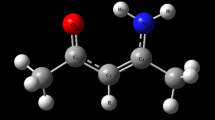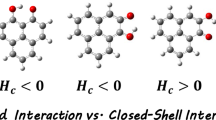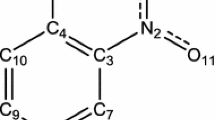Abstract
The hydrogen bond strength, molecular geometry, π-electron delocalization, and physical properties such as dipole moment, chemical potential, and chemical hardness of 4-nitropyridine-3-thiol and its 29 derivatives have been studied by means of density functional method with 6-311++G** basis set in gas phase and water solution. Also, the excited-state properties of intramolecular hydrogen bonding in these systems have been investigated theoretically using the time-dependent density functional theory method. The HOMA, NICS, PDI, ATI, FLU, and FLUπ indices as well-established aromaticity indicators have been examined. Natural bond orbital analysis is also performed for better understanding the nature of intramolecular interactions. The electron density and Laplacian (∇2 ρ) properties, estimated by AIM calculations, indicate that H···O bond possesses low ρ and positive ∇2 ρ values, which are in agreement with electrostatic character of the HBs, whereas S–H bond has covalent character. Numerous correlations between topological, geometrical, and energetic parameters are also found.






Similar content being viewed by others
References
Middleton JC, Carpenter KJ (2007) Ullmann’s encyclopedia of industrial chemistry: electronic release, Wiley-VCH, Weinheim
Patel NB, Agravat SN, Shaikh FM (2011) Synthesis and antimicrobial activity of new pyridine derivatives-I. Med Chem Res 20:1033–1041
Patel NB, Agravat SN (2009) Synthesis and antimicrobial studies of new pyridine derivatives. Chem Heterocycl Compd 45:1343–1353
Srivastava A, Pandeya SN (2011) “Indole” a versatile nucleuse in pharmaceutical field. Int J Curr Pharm Rev Res 4:5–8
Paronikyan EG, Noravyan AS, Dzhagatspany IA, Nazaryan IM, Paronikyan RG (2002) Synthesis and anticovulsant activity of isothiazolo-[5,4-b]-pyrano (thiopyrano)-[4,3-d]-pyridine and isothiazolo [4,5-b]-2,7-naphthyridine derivatives. Pharm Chem J 36:465–467
Bernardino AMR, De Azevedo AR, Pinheiro LCD, Borges JC, Carvalho VL, Miranda MD, De Meneses MDF, Nascimento M, Ferreira D, Rebello MA et al (2007) Syntehsis and antiviral activity of new 4-(phenylamino)/4-[(methylpidin-2-yl) amino]-1-phenyl-1H-pyrazolo-[3,4-b]-pyridine-4-carboxylic acid derivatives. Med Chem Res 16:352–369
Tucker TJ, Sisko JT, Tynebor RM, Williams TM, Felock PJ, Flynn JA, Lai M, Liang Y, McGaughey G, Liu M et al (2008) Discovery of 3-{5-[(6-amino-1H-pyrazolo[3,4-b]pyridine-3-yl)methoxy]-2-chlorophenoxy}-5-chlorobenzonitrile (MK-4965): a potent, orally bioavailable HIV-1 non-nucleoside reverse transcriptase inhibitor with improved potency against key mutant viruses. J Med Chem 51:6503–6511
Mamolo MG, Zampieri D, Falagiani V, Vio L, Fermeglia M, Ferrone M, Pricl S, Banfi E, Scialino G (2004) Antifungal and antimycobacterial activity of new N1-[1-aryl-2-(1Himidazol-1-yl and 1H-1,2,4-triazol-1-yl)-ethylidene]-pyridine-2-carboxamidrazone derivatives: a combined experimental and computational approach. ARKIVOC 5:231–250
Balachandran V, Lakshmi A, Janaki A (2012) Conformational stability, vibrational spectral studies, HOMO–LUMO and NBO analyses of 2-hydroxy-4-methyl-3-nitropyridine and 2-hydroxy-4-methyl-5-nitropyridine based on density functional theory. J Mol Struct 1013:75–85
Gangjee A, Adair A, Queener O, Pneumo SF (1999) Pneumocystis carinii and Toxoplasmo gondii dihydrofoflate reductase inhibitors and antitumor agends: synthesis and biological activities of 2,4-diamino-5-methyl-6-[(monosubstituted aniline)methyl]-pyrido [2,3-d] pyrimidines. J Med Chem 42:2447–2455
Geffken D, Soliman R, Soliman FSG, Abdel-Khalek MM, Issa DAE (2011) Synthesis of new series of pyrazolo[4,3-d]pyrimidin-7-ones and pyrido [2,3-d] pyrimidin-4-ones for their bacterial and cyclin-dependent kinases (CDKs) inhibitory activities. J Med Chem Res 20:408–420
Nasr MN, Gineinah MM (2002) Pyrido [2,3-d] pyrimidines and pyrimido [5′,4′:5,6] pyrido [2,3-d] pyrimidines as new antiviral agents: synthesis and biological activity. Arch Pharm 335:289
Jones G (1996) Comprehensive heterocyclic chemistry II; Katritzky AR, Rees CW, Scriven EFV, Eds.; Pergamon: Oxford 5, pp 167–243
Chen J, Ling G, Lu S (2003) Synthesis of new unsymmetric N, N’-dipyridylurea derivatives by selenium and selenium dioxide-catalyzed reductive carbonylation of substituted nitropyridines. Tetrahedron 59:8251–8256
Jeffrey GA (1997) An introduction to hydrogen bonding. Oxford University Press, New York
Jeffrey GA, Saenger W (1991) Hydrogen bonding in biological structures. Springer, Berlin
Zhao GJ, Han KL (2012) Hydrogen bonding in the electronic excited state. Acc Chem Res 45:404–413
Zhao G, Yu F, Zhang M, Northrop B, Yang H, Han K, Stang P (2011) Substituent effects on the intramolecular charge transfer and fluorescence of bimetallic platinum complexes. J Phys Chem A 115:6390–6393
Cao X, Liu C, Liu Y (2012) Theoretical studies on the mechanism of cyclic nucleotide monophosphate hydrolysis within phosphodiesteres. Theor Comput Chem 11:573–586
Raymo FM, Bartberger MD, Houk KN, Stoddart JF (2001) The magnitude of [C–H***O] hydrogen bonding in molecular and supramolecular assemblies. J Am Chem Soc 123:9264–9267
Glasbeek M, Zhang H (2004) Femtosecond studies of solvation and intramolecular configurational dynamics of fluorophores in liquid solution. Chem Rev 104:1929–1954
Yi YR, Lee IJ, Photochem J (2002) Photoreactions of spirophenanthrooxazine dispersed in polystyrene film at room temperature. Photobiol A 151:89–94
Frisch MJ, Trucks GW, Schlegel HB, Scuseria GE, Robb MA, Cheeseman JR, Montgomery JA, Vreven Jr, T, Kudin KN, Burant JC, Millam JM, Iyengar SS, Tomasi J, Barone V, Mennucci B, Cossi M, Scalmani G, Rega N, Petersson GA, Nakatsuji H, Hada M, Ehara M, Toyota K, Fukuda R, Hasegawa J, Ishida M, Nakajima T, Honda Y, Kitao O, Nakai H, Klene M, Li X, Knox JE, Hratchian HP, Cross JB, Adamo C, Jaramillo J, Gomperts R, Stratmann RE, Yazyev O, Austin AJ, Cammi R, Pomelli C, Ochterski JW, Ayala PY, Morokuma K, Voth GA, Salvador P, Dannenberg JJ, Zakrzewski VG, Dapprich S, Daniels AD, Strain MC, Farkas O, Malick DK, Rabuck AD, Raghavachari K, Foresman JB, Ortiz JV, Cui Q, Baboul AG, Clifford S, Cioslowski J, Stefanov BB, Liu G, Liashenko A, Piskorz P, Komaromi I, Martin RL, Fox DJ, Keith T, Al-Laham M A, Peng CY, Nanayakkara A, Challacombe M, Gill PMW, Johnson B, Chen W, Wong MW, Gonzalez C, Pople JA, Gaussian 03, Revision C.02 (or D.01), Gaussian, Inc., Pittsburgh (2003)
Becke AD (1993) Density-functional thermochemistry. III. The role of exact exchange. J Chem Phys 98:5648–5652
Espinosa E, Molins E (2000) Retrieving interaction potentials from the topology of the electron density distribution: the case of hydrogen bonds. J Chem Phys 113:5686–5694
Espionsa E, Souhassou M, Lachekar H, Lecomte C (1999) Topologicalanalysis of the electron density in hydrogen bonds. Acta Crystallogr B 55:563–572
Abramov YA (1997) On the possibility of kinetic energy density evaluation from the experimental electron-density distribution. Acta Crystallogr A 53:264–272
Gonza′ les L, Mo′ O, Ya′nˇ es M (1997) High-level ab initio calculations on the intramolecular hydrogen bond in thiomalonaldehyde. J Phys Chem A 101:9710–9719
Bader RFW (1990) Atoms in molecules—a quantum theory. Clarendon Press, Oxford
AIM2000 designed by Friedrich Biegler-Ko¨ nig, University of Applied Sciences, Bielefeld
Biegler-Ko¨ nig FW, Bader RFW, Tang YH, Tal Y (1982) Calculation of the average properties of atoms in molecules. J Comput Chem 3:317–328
Glendening ED, Reed AE, Carpenter JE, Weinhold F (1992) NBO, Version 3.1, Gaussian, Inc., Pittsburgh
Glendening DE, Reed AE, Carpenter JE, Weienhold F (1996) NBO, Version 3.1
Wendt M, Weinhold F (2001) NBOView 1.0: Theoretical Chemistry Institute. University of Wisconsin, Madison
Chen Z, Wannere CS, Corminboeuf C, Puchta R, Schleyer PVR (2005) Nucleus-independent chemical shifts (NICS) as an aromaticity criterion. Chem Rev 105:3842–3888
Kruszewski J, Krygowski TM (1972) Definition of aromaticity basing on the harmonic oscillator model. Tetrahedron Lett 13:3839–3842
Schleyer PVR, Maerker C, Dransfeld A, Jiao H, van Eikema Hommes NJR (1996) Nucleus-independent chemical shifts: a simple and efficient aromaticity probe. J Am Chem Soc 118:6317–6318
Krygowski TM, Cyranski MK (1996) Separation of the energetic and geometric contributions to the aromaticity of π-electron carbocyclics. Tetrahedron 52:1713–1722
Poater J, Fradera X, Duran M, Solà M (2003) Three-dimensional structure-activity relationship modeling of cross-reactivities of a polyclonal antibody against pyrene by comparative molecular field analysis. Chem Eur J 9:400–406
Bultinck P, Ponec R, Van Damme S (2005) Multicenter bond indices as a new measure of aromaticity in polycyclic aromatic hydrocarbons. J Phys Org Chem 18:706–718
Matito E, Duran M, Sola` M (2005) The aromatic fluctuation index (FLU): a new aromaticity index based on electron delocalization. J Chem Phys 122:014109
Matito E, Salvador P, Duran M, Solà M (2006) Aromaticity measures from fuzzy-atom bond orders. The aromatic fluctuation (FLU) and the para-delocalization (PDI) indexes. J Chem Phys A 110:5108–5113
Miertus S, Scrocco E, Tomasi J (1981) Electrostatic interaction of a solute with a continuum. A direct utilization of ab initio molecular potentials for the prevision of solvent effects. J Chem Phys 55:117
Kang YK, Némethy G, Scheraga HA (1987) Dissociation of cyclohexene and 1,4-cyclohexadiene in a molecular beam. J Phys Chem 91:4118–4122
Liptak MD, Shields GC (2001) Accurate pKa calculations for carboxylic acids using complete basis set and gaussian-n models combined with CPCM continuum solvation methods. J Am Chem Soc 123:7314–7319
Tissandier MD, Cowen KA, Feng WY, Gundlach E, Cohen MH, Earhart AD, Coe JV, Tuttle TR Jr (1998) The proton’s absolute aqueous enthalpy and gibbs free energy of solvation from cluster-ion solvation data. J Phys Chem A 102:7787–7794
Parr RG, Pearson RGJ (1983) Absolute hardness: companion parameter to absolute electronegativity. J Am Chem Soc 105:7512–7516
Parr RG, Donnelly RA, Levy M, Palke WE (1978) Electronegativity: the density functional viewpoint. J Chem Phys 68:3801–3807
Iczkowski RP, Margrave JL (1961) Electronegativity. J Am Chem Soc 83:3547
Pearson RG (1985) Hardness, softness, and the fukui function in the electronic theory of metals and catalysis. Proc Natl Acad Sci USA 82:6723–6726
Pearson RG (1985) Absolute electronegativity and absolute hardness of Lewis acids and bases. J Am Chem Soc 107:6801–6806
Parr RG, Chattaraj PK (1991) Principle of maximum hardness. J Am Chem Soc 113:1854–1855
Raissi H, Yoosefian M, Mollania F, Farzad F, Nowroozi AR, Loghmaninejad D (2011) Ab initio and DFT computational studies on molecular conformations and strength of the intramolecular hydrogen bond in different conformers of 3-amino-2-iminomethyl acryl aldehyde. J Comput Theor Chem 966:299–305
Raissi H, Farzad F, Eslamdoost S, Mollania F (2013) Conformational properties and intramolecular hydrogen bonding of 3-Amino-Propeneselenal: an ab-initio and density functional theory studies. J Theor Comput Chem 12:1350025–1350042
Raissi H, Yoosefian M, Moshfeghi E, Farzad F (2012) Theoretical study on β-aminoacroleine: density functional theory, atoms in molecules theory and natural bond orbitals studies. J Chem Sci 124:731–739
Grabowski SJ (2001) Hydrogen bonding strength—measures based on geometric and topological parameters. J Phys Chem A 105:10739–10746
Grabowski SJ (2001) An estimation of strength of intramolecular hydrogen bonds—Ab initio and AIM studies. J Mol Struct 562:137–143
Cuma M, Scheiner S, Kar T (1999) Effect of adjoining aromatic ring upon excited state proton transfer, o-hydroxybenzaldehyde. J Mol Struct (Theochem) 467:37–49
Sobczyk L, Grabowski SJ, Krygowski TM (2005) Interrelation between H-bond and pi-electron delocalization. Chem Rev 105:3513–3560
Mo O, Yanez M, Elguero J (1992) Cooperative (nonpairwise) effects in water trimers: an ab initio molecular orbital study. J Chem Phys 97:6628–6638
Rozas I, Alkorta I, Elguero J (2000) Behavior of ylides containing N, O, and C atoms as hydrogen bond acceptors. J Am Chem Soc 122:11154–11161
Koch U, Popelier P (1995) Characterization of C–H–O hydrogen bonds on the basis of the charge density. J Phys Chem A 99:9747–9754
Popelier P (2000) Atoms in molecules. An introduction. Prentice-Hall, Englewood
Alkorta I, Rozas I, Elguero J (1998) Non-convenional hydrogen bonds. Chem Soc Rev 27:163–170 and references cited therein
González L, Mó O, Yánéz M, Elguero J (1998) Very strong hydrogen bonds in neutral molecules: the phosphinic acid dimers. J Chem Phys 109:2685–2693
Grabowski SJ (2011) What is the covalency of hydrogen bonding? Chem Rev 111:2597–2625
Raissi H, Yoosefian M, Mollania F (2012) Comprehensive study of the interaction between hydrogen halides and methanol derivatives. Int J Quant Chem 112:2782–2786
Alkorta I, Rozas I, Elguero J (1998) Radicals as hydrogen bond acceptors. Ber Bunsen Ges Phys Chem 102:429–435
Cremer D, Kraka E (1984) Chemical bonds without bonding electron density. Angew Chem Int Ed Engl 23:627–628
Palusiak M, Krygowski TM (2007) Application of AIM parameters at ring critical points for estimation of π-electron delocalization in six-membered aromatic and quasi-aromatic rings. Chem Eur J 13:7996–8006
Grabowski SJ (2001) A new measure of hydrogen bonding strength—ab initio and atoms in molecules studies. Chem Phys Lett 338:361–366
Hobza P, Spirko V, Selzle HL, Schlag EW (1998) Anti-hydrogen bond in the benzene dimer and other carbon proton donor complexes. J Phys Chem A 102:2501–2504
Gilli G, Gilli P (2000) Towards an unified hydrogen-bond theory. J Mol Struct 552:1–15
Gilli G, Bellucci F, Ferretti V, Bertolasi V (1989) Evidence for resonance-assisted hydrogen bonding from crystal-structure correlations on the enol form of the.beta.-diketone fragment. J Am Chem Soc 111:1023–1028
Hansch C, Leo A, Taft RW (1991) A survey of hammett substituent constants and resonance and field parameters. Chem Rev 97:165–195
Magill AM, Cavell KJ, Yates BF (2004) Basicity of nucleophilic carbenes in aqueous and nonaqueous solventstheoretical predictions. J Am Chem Soc 126:8717–8724
Fu Y, Liu L, Yu HZ, Wang Y, Guo QX (2005) Quantum-chemical predictions of absolute standard redox potentials of diverse organic molecules and free radicals in acetonitrile. J Am Chem Soc 127:7227–7234
Qi X, Fu Y, Liu L, Guo Q (2007) Ab initio calculations of thermodynamic hydricities of transition-metal hydrides in acetonitrile. Organometallics 26:4197–4203
Choi J, Pulling ME, Smith DM, Norton JR (2008) Unusually weak metal–hydrogen bonds in HV(CO)4(P–P) and their effectiveness as H· donors. J Am Chem Soc 130:4250–4252
Nieto I, Ding F, Bontchev RP, Wang H, Smith JM (2008) Thermodynamics of hydrogen atom transfer to a high-valent iron imido complex. J Am Chem Soc 130:2716–2717
Ögretir C, Özögüt D, Yarligan S, Arslan T (2006) Quantum chemical studies on acidity–basicity behaviours of some substituted pyridine derivatives. J Mol Struct (Theochem) 759:73–78
Jalbout AF, Fernandez S (2002) Part II. Gaussian, complete basis set and density functional theory stability evaluation of the singlet states of Cn (n = 1–6): energy differences, HOMO–LUMO band gaps, and aromaticity. J Mol Struct 584:169–182
Pearson RG (2001) Dowden. Hutchison & Ross, Stroudsburg
Murray JS, Sen K (1996) Molecular electrostatic potentials, concepts and applications. Elsevier, Amsterdam
Scrocco E, Tomasi J (1978) In: Lowdin P (ed) Advances in quantum chemistry, vol II. Academic Press, New York
Author information
Authors and Affiliations
Corresponding author
Rights and permissions
About this article
Cite this article
Raissi, H., Khoshbin, Z. & Mollania, F. The analysis of structural and electronic properties for assessment of intramolecular hydrogen bond (IMHB) interaction: a comprehensive study into the effect of substitution on intramolecular hydrogen bond of 4-nitropyridine-3-thiol in ground and electronic excited state. Struct Chem 25, 515–538 (2014). https://doi.org/10.1007/s11224-013-0314-1
Received:
Accepted:
Published:
Issue Date:
DOI: https://doi.org/10.1007/s11224-013-0314-1




